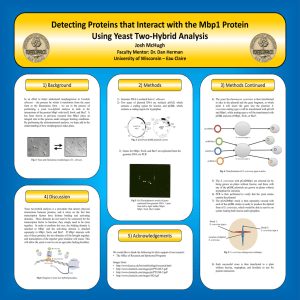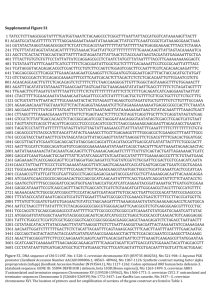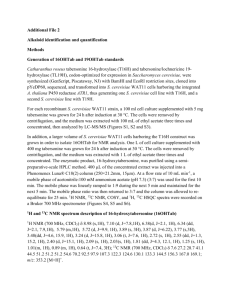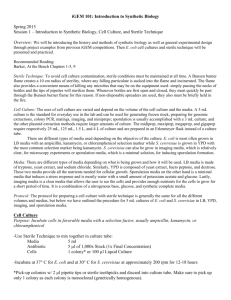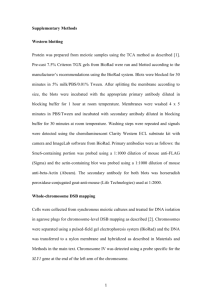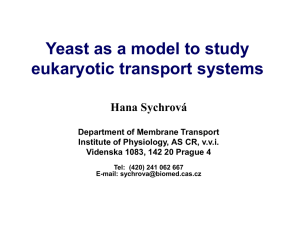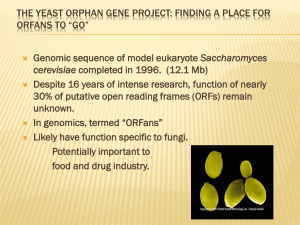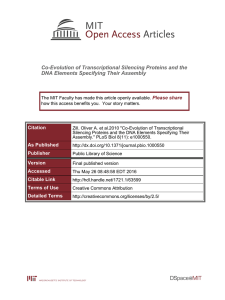Exploring the Effects of YAK1 on Cellular
advertisement
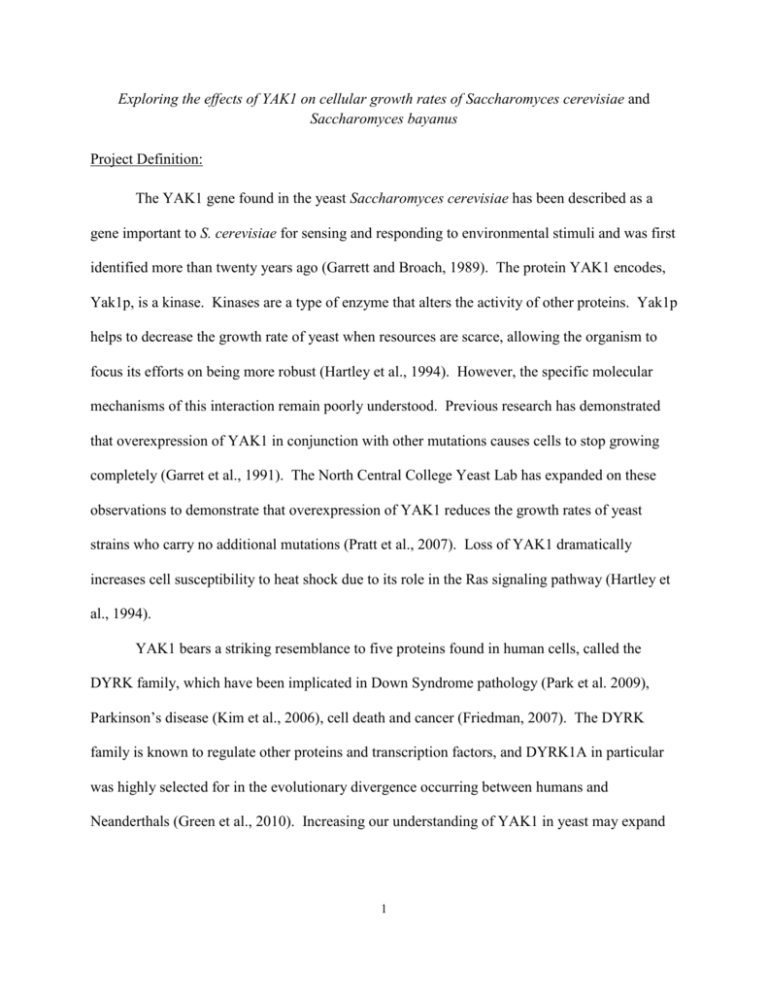
Exploring the effects of YAK1 on cellular growth rates of Saccharomyces cerevisiae and Saccharomyces bayanus Project Definition: The YAK1 gene found in the yeast Saccharomyces cerevisiae has been described as a gene important to S. cerevisiae for sensing and responding to environmental stimuli and was first identified more than twenty years ago (Garrett and Broach, 1989). The protein YAK1 encodes, Yak1p, is a kinase. Kinases are a type of enzyme that alters the activity of other proteins. Yak1p helps to decrease the growth rate of yeast when resources are scarce, allowing the organism to focus its efforts on being more robust (Hartley et al., 1994). However, the specific molecular mechanisms of this interaction remain poorly understood. Previous research has demonstrated that overexpression of YAK1 in conjunction with other mutations causes cells to stop growing completely (Garret et al., 1991). The North Central College Yeast Lab has expanded on these observations to demonstrate that overexpression of YAK1 reduces the growth rates of yeast strains who carry no additional mutations (Pratt et al., 2007). Loss of YAK1 dramatically increases cell susceptibility to heat shock due to its role in the Ras signaling pathway (Hartley et al., 1994). YAK1 bears a striking resemblance to five proteins found in human cells, called the DYRK family, which have been implicated in Down Syndrome pathology (Park et al. 2009), Parkinson’s disease (Kim et al., 2006), cell death and cancer (Friedman, 2007). The DYRK family is known to regulate other proteins and transcription factors, and DYRK1A in particular was highly selected for in the evolutionary divergence occurring between humans and Neanderthals (Green et al., 2010). Increasing our understanding of YAK1 in yeast may expand 1 our knowledge of the human DYRK genes, including their role in human disease as well as their evolutionary significance. A close relative of S. cerevisiae, Saccharomyces bayanus, has a gene with YAK1 homology that has been rendered defective by the presence of a stop codon in the middle of YAK1’s kinase domain. A stop codon would stop the cell machinery of S. bayanus in the middle of producing the YAK1 protein. S. bayanus has been shown to produce the truncated protein, which is missing most of the kinase domain and the entire C-terminus. Denoted “Yak1a”, little is known regarding whether or not this protein has a function in S. bayanus. S. cerevisiae and S. bayanus are thought to have descended from a common ancestor before evolving into two separate species approximately 20 million years ago. S. bayanus fills a different ecological niche than S. cerevisiae despite their close relation. S. cerevisiae grows optimally at 30°C while feeding on dextrose, a fermentable carbon source, while S. bayanus experiences optimal growth at 25°C while feeding on glycerol, a non-fermentable carbon source (Lee et al., 2008). The North Central Yeast Lab has hypothesized that the removal of functional YAK1 from S. bayanus contributed to the evolutionary phenomena that transformed one ancestor yeast into the two daughter species S. cerevisiae and S. bayanus. In order to explore YAK1’s function in S. cerevisiae and S. bayanus, we have genetically modified YAK1 in both species with a variety of different modifications. We have altered endogenous YAK1 in some strains and added YAK1 from other species. These YAK1 mutants will be subjected to growth curve trials in order to determine their growth rates. Measuring the growth rates of the mutants is an efficient way to determine YAK1’s effect on the organism’s optimal niche. My research would attempt to answer several questions about YAK1’s role in controlling growth rates: 2 Does giving S. bayanus a functional copy of S. cerevisiae YAK1 affect its growth rate? How does disabling the kinase domain of S. cerevisiae YAK1 affect the growth of S. cerevisiae with and without the presence of its normal YAK gene? How does disabling the kinase domain of S. cerevisiae YAK1 and cloning it into S. bayanus affect the growth of S. bayanus? Does giving S. bayanus YAK1 to S. cerevisiae affect growth rates with and without its own functional YAK1 gene? How does giving both S. cerevisiae and S. bayanus only the C-terminus of S. cerevisiae YAK1 affect growth rates? Answering these questions would provide an expanded insight into the function of Yak1p and possibly increase our understanding of the speciation event that led S. cerevisiae and S. bayanus to occupy two different ecological niches. The process of constructing growth curves for so many strain comparisons is very slow at North Central’s Yeast Lab: with the equipment available here, I am only able to run one growth curve per week. I hope to accelerate the pace of my project by pursuing it at the University of Minnesota, where Dr. Judy Berman has offered me the opportunity to use an instrument that will increase my productivity by nearly 100-fold. Methodology: My proposal is to pursue these research questions at an expedited pace by using the extensive resources available at the University of Minnesota. In order to better understand YAK1’s role in controlling the growth rates of S. cerevisiae and S. bayanus, I will construct growth curves comparing various S. cerevisiae and S. bayanus strains with various YAK1 mutations. A growth curve is constructed by using a spectrophotometer to measure the optical density of an aqueous cell culture. Spectrophotometers pass light through a sample of the culture 3 and measure the amount of light transmitted through the solution. From that measurement, one can determine the approximate density of cells in the culture. Taking the measurements over several time intervals and recording the optical densities of the culture at those times allows one to construct a curve from which a growth rate can be determined. Yeast growth is logarithmic, beginning with a phase of cell doubling until resources are depleted and the culture enters stationary phase, where growth levels off. The slope of this line is the growth rate. Figure 1: Example of an idealized growth curve set made by Mark McClellan with the Tecan plate shaker/incubator/spectrophotometer, the instrument I will be using to construct my curves. Constructing growth curves is a tedious exercise. Working on my project over the summer, I was able to construct two growth curves, each taking a week respectively to complete. 4 Dr. Berman has offered to allow me to use an instrument in her lab at the University of Minnesota capable of running 96 growth curves at a time. This would greatly increase the efficiency of my data collection, allowing me to run enormous sample sizes in comparatively short time. In order to answer multiple research questions simultaneously, I will be constructing growth curves for a multitude of YAK mutants, half in S. cerevisiae and half in S. bayanus. The mutants will be examined alongside wildtype yeast that have normal YAK1 as a control. In order to allow for the inclusion of error bars in the growth curves, I will be running the assays in triplicate to allow for statistical analyses of the results. The cultures will be grown at 22°C (room temperature) and in dextrose, the preferred media of S. cerevisiae. In order to attempt to address the multitude of questions I hope to answer, I will be using a variety of yeast strains in my growth curve trials. S. cerevisiae 364 wildtype normal YAK1 control 1231 wildtype, ura+ Normal YAK1, allows growth without uracil 1312 yak1::TRP YAK1 deletion mutant 1232 pADH-ScYAK1 YAK1 high overexpression mutant 1310 YEp-ScYAK1 YAK1 overexpression mutant 1311 YEp-Scyak1-k398r YAK1 kinase-dead mutant 1306 YEp-SbYAK1 S. bayanus YAK1 along with normal S. cerevisiae YAK1 5 1326 YEp-ScYAK1-C C-terminus of YAK1 added to normal YAK1 1327 YEp-Scyak1- k398r -C Kinase-dead YAK1 with YAK1 C-terminus and normal YAK1 1330 yak1::TRP YEp-ScYAK1-C YAK1 deletion with YAK1 Cterminus 1331 yak1::TRP YEp-Scyak1k398r -C YAK1 deletion mutant with Kinase-dead YAK1 and YAK1 C-terminus ySb8 wildtype normal YAK1 control ySb10 wildtype, ura+ normal YAK1, allows growth without uracil ySb12 yak1::HIS YAK1 deletion mutant ySb11 pADH-ScYAK1 High-expression cerevisiae YAK1 along with normal bayanus YAK1 ySb24 YEp-ScYAK1 cerevisiae YAK1 along with normal bayanus YAK1 ySB25 YEp-Scyak1- k398r cerevisiae YAK1 kinase-dead mutant ySb26 YEp-SbYAK1 YAK1 overexpression ySb40 YCp-ScYAK1 Single copy of the S. cerevisiae YAK1 gene ySb42 YEp-ScYAK1-C cerevisiae YAK1 C-terminus ySb43 YEp-Scyak1- k398r -C cerevisiae YAK1 C-terminus, kinase-dead S. bayanus 6 Time permitting, I would also hope to run additional experiments using glycerol instead of dextrose as the yeast’s carbon source in order to explore whether or not growth media plays a role in YAK function. It might also be helpful to conduct further trials at 25 and 30°C, the preferred temperatures of S. bayanus and S. cerevisiae, respectively. I plan to follow the following research schedule during my two weeks at University of Minnesota: December Week 1 Week 2 Sunday Monday Tuesday Wednesday Thursday Friday Saturday 5 6 7 8 9 10 11 Arrive in Meet lab Place Berman lab Berman Berman lab Minneapolis staff, start cultures in work lab work work cultures Tecon 13 14 15 16 17 Berman Berman Berman lab Collect Leave lab work lab work work final Minneapolis 12 results I discussed the schedule with Dr. Johnston, who believes the above timetable to be reasonable for the trials I plan to run. The growth curves require some initial setup, but will run automatically most of the time. In the mean time, I will be given work to do by one of Dr. Berman’s lab technicians, Mark McClellan. I will collect the results of my experiment on my final lab day and analyze the data in light of our previous research when I return to North Central. Results: The data I collect will be organized into a professional poster and interpreted in the light of the North Central College Yeast Lab’s previous research into the relationship between YAK1 7 and the speciation of S. cerevisiae and S. bayanus. The poster will be presented at the Rall Symposium and NCUR. Relevant Experience: I have taken BIO 102 and I am currently enrolled in BIO 260. These two courses carry a heavy emphasis on genetics and molecular biology, the two major themes I need to familiarize myself with in order to complete this research project. In addition, I participated in the Summer Research Program 2010 in Dr. Johnston’s Yeast Lab for six weeks. During this time, I was introduced to my project when I began measuring the optical density of yeast cultures grown at a variety of temperatures and with different carbon food sources. I made the plasmids used to make Sc strain 1331 and Sb strain 43 and constructed initial growth curves that showed some promise. I also attended the Midwest Yeast Meeting 2010 with Dr. Johnston in order to watch other yeast geneticists present their work, where I was introduced to Dr. Berman and offered the opportunity to work in her lab over D-term. The Midwest Yeast Meeting was a valuable experience because I was able to watch a plethora of professional presentations of research in the field of study my project falls into. Personal Application: Based on my experience with summer research, I am considering research as my primary career interest and I’m planning on attending graduate school. Completing this project at Dr. Berman’s lab will allow me to experience graduate school before I actually get there. I want to make sure that working in a lab is in fact the career I want to pursue, something I can only know by learning firsthand what a big research lab is like. In order to give me the full graduate school experience, Dr. Berman will be handing me tasks related to her research in addition to my own 8 project, allowing me to try out other techniques and familiarize myself with instruments not available at the North Central lab. References: Friedman, E. 2007. Mirk/Dyrk1B in cancer. J. Cell. Biochem. 102:274-279. The author, Eileen Friedman, received her PhD at Johns Hopkins University and is a professor of pathology at Upstate Medical University in New York. The article discusses the Mirk/Dyrk1B gene’s function in the cellular repair of cancerous tumors. This article was useful in finding relevant medical concerns for the study of YAK1, which shares homology with the DYRK family. Garret, S. and J. Broach. 1989. Loss of Ras activity in Saccharomyces cerevisiae is suppressed by disruptions of a new kinase gene, YAK1, whose product may act downstream of the cAMP-dependent protein kinase. Genes Dev 3: 1336-48. The bulk of the article revolves around the discovery of YAK1’s role in the RAS/cAMP signal transduction pathway and the construction of a tentative model to characterize how it functions. The preliminary model presented here lead to the author’s second YAK1centered paper, which further characterizes YAK1’s role in the regulation of growth rates. Garret, S., M.M. Menold and J.R. Broach. 1991. The Saccharomyces cerevisiae YAK1 gene encodes a protein kinase that is induced by arrest early in the cell cycle. Mol Cell Biol 11: 4045-52. The follow-up article to Garrett’s previous work on YAK1 firmly establishes YAK1 as a protein kinase working in opposition to A kinase to regulate yeast growth. This article is important for its characterization of YAK1’s function in S. cerevisiae as a negative growth regulator. 9 Green, R.E., J. Krause, A.W. Briggs, T. Maricic, U. Stenzel, M. Kircher, N. Patterson, H. Li, W. Zhai, M.H.-Y. Fritz, N.F. Hansen, E.Y. Durand, A.-S. Malaspinas, J.D. Jensen, T. Marques-Bonet, C. Alkan, K. Prüfer, M. Meyer, H.A. Burbano, J.M. Good, R. Schultz, A. Aximu-Petri, A. Butthof, B. Höber, B. Höffner, M. Siegemund, A. Weihmann, C. Nusbaum, E.S. Lander, C. Russ, N. Novod, J. Affourtit, M. Egholm, C. Verna, P. Rudan, D. Brajkovic, Z. Kucan, I. Gusic, V.B. Doronichev, L.V. Golovanova, C. Lalueza-Fox, M. de la Rasilla, J. Fortea, A Rosas, R.W. Schmitz, P.L.F. Johnson, E.E. Eichler, D. Falush, E. Birney, J.C. Mullikin, M. Slatkin, R. Nielson, J. Kelso, M. Lachmann, D. Reich, and S. Pääbo. 2010. A draft sequence of the Neandertal genome. Science 328: 710-722. This publication presents the results of a genomic sequencing of the Neandertal genome from three individuals, allowing the researchers to identify genes important in the evolution of Neandertals into humans. DYRK1A is mentioned among these genes, a YAK1 homolog in humans implicated in Downs syndrome, another point of medical relevance for the project. Hartley, A.D., M.P. Ward, and S. Garrett. 1994. The Yak1 protein kinase of Saccharomyces cerevisiae moderates thermotolerance and inhibits growth by an Sch9 protein kinaseindependent mechanism. Genetics 136, 465-74. The article demonstrates that YAK1 has a key role in the development of heat resistance and has a broader role than simply suppressing the A kinase growth defect in S. cerevisiae. It is important for my project because it elaborates on YAK1’s role in responding to environmental stimuli and further develops its function in S. cerevisiae. Kim, E.J., J.Y. Sung, H.J. Lee, H. Rhim, M. Hasegawa, T. Iwatsubo, D.S. Min, J. Kim, S.R. Paik, 10 K.C. Chung. 2006. Dyrk1a phosphorylates α-synuclein and enhances intracellular inclusion formation. J. Biol. Chem. 281: 33250-33257. This article suggests that Dyrk1A regulates α-synuclein through phosphorylation in immortalized hippocampal neuronal cells, sometimes leading to the formation of neurotoxic aggregate bodies and cell death. The findings implicate DYRK1A in Parkinson’s disease, and YAK1 shares strong homology with the DYRK family. Lee, H.-Y., J.-Y. Chou, L. Cheong, N.-H. Chang, S.-Y. Yang and J.-Y. Leu. 2008. Incompatibility of nuclear and mitochondrial genomes causes hybrid sterility between two yeast species. Cell. 135:1065-1073. Lee et al. work to describe the evolutionary divergence of S. cerevisiae and S. bayanus in their article, citing differences in mitochondrial DNA as the reason the two species cannot interbreed and produce viable offspring. This article was essential to my project because it is of paramount importance to understand the established evolutionary background of two species before trying to expand on it. Park, J., Y. Oh and K.C. Chung. 2009. Two key genes closely implicated with the neuropathological characteristics of Down syndrome: DYRK1A and RCAN1. BMB Rep. 42:6-15. Park et al. explore the roles two genes, DYRK1A and RCAN1, play in Down syndrome pathology in hopes of better understanding the molecular mechanisms of the disease. YAK1’s homology to DYRK1A adds medical relevance to my project background. Pratt, Z.L., B.J. Drehman, M.E. Miller and S.D. Johnston. 2007. Mutual interdependence of MSI1 (CAC3) and YAK1 in Saccharomyces cerevisiae. J. Mol. Biol. 368:30-43. 11 This article identifies several new interactions between the S. cerevisiae genes MSI1 and YAK1, expanding our knowledge of YAK1’s function in S. cerevisiae. It was published out of the North Central College Yeast Lab and provides valuable insight into the developmental history of my project. 12
